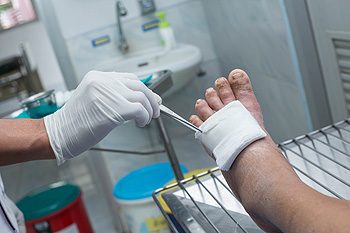
Bed sores, also known as pressure ulcers, can develop on the lower limbs when prolonged pressure reduces blood flow to the skin. People who are confined to a bed or chair, or those with limited mobility, are most at risk. The feet, heels, and ankles are particularly vulnerable because bony areas press against surfaces for long periods of time. Early signs may include redness, tenderness, or changes in skin texture. If left untreated, bed sores can progress into deeper wounds that are difficult to heal and prone to infection. Prevention is key and involves regularly changing positions, using cushioning or support devices, and keeping the skin clean and dry. Good nutrition and circulation also play important roles in healing. Because lower limb bed sores can be complex, it is suggested that you see a wound care specialist for tailored treatment and management.
Pressure Sores, Pressure Ulcers, and Arterial Ulcers Can Lead to Skin Breakdown
Not all wounds on the feet, ankles, and legs are the same. Pressure sores, pressure ulcers, and arterial ulcers may look similar at first, but develop for different reasons and require specialized care. Understanding these differences is key to proper treatment.
Pressure sores are often caused by friction at common rubbing points. Toes rubbing against each other can create small raw areas, while wearing ill-fitting shoes may lead to sores on the heel, ankle, or sides of the foot. These injuries usually begin at the surface but can quickly deepen if ignored.
Pressure ulcers, sometimes called bedsores, occur when the skin and tissue are compressed between bone and an external surface for long periods of time. On the lower extremities, they frequently appear on the heels, ankles, calves, or shins. Limited mobility, tight footwear, or prolonged bed rest can all contribute to these ulcers, which may progress through multiple stages from redness to open, infected wounds.
Arterial ulcers are different in that they result from poor circulation. When blood flow to the feet and legs is reduced, oxygen and nutrients cannot reach the tissue. Even small sores on the toes, heels, or shins may become painful, deep ulcers that heal very slowly. Unlike friction-related sores, arterial ulcers are directly tied to vascular health and often signal an underlying circulation problem.
All three types of wounds demand professional attention. A wound care specialist can determine the cause, relieve pressure, improve circulation when possible, and use advanced techniques to promote healing.
If you notice a sore on your foot, ankle, or leg that is slow to close or worsening, call us for timely care to help prevent serious complications and preserve long-term mobility.
